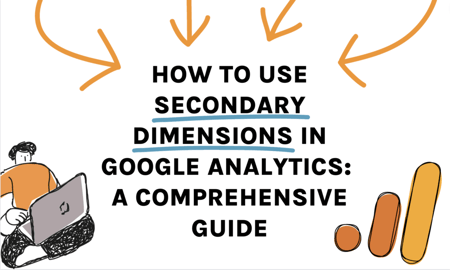Unlocking SEO Success with Advanced Analytics and Secondary Dimensions
Unlocking SEO Success with Advanced Analytics and Secondary Dimensions
Blog Article
Optimize Your Reporting Precision With Secondary Dimensions
In the world of information evaluation, the pursuit for accuracy and deepness is a continuous quest. Additional dimensions provide an entrance to enhancing reporting accuracy by offering a diverse lens whereby to check out information. Envision the power of unraveling complex layers of info that lie beyond the surface metrics, providing a richer tapestry of insights waiting to be checked out. As we start this journey of leveraging additional dimensions, the landscape of reporting accuracy bids with assurances of boosted quality and critical decision-making.
Significance of Additional Dimensions
Making use of additional measurements is crucial for boosting the depth and granularity of reporting insights in information analysis. Secondary dimensions make it possible for analysts to section and filter information based on particular criteria, giving a more tailored and targeted evaluation.
Additionally, secondary measurements assist in identifying relationships and relationships that might not be promptly obvious when assessing data with just primary dimensions. This much deeper level of understanding can cause even more educated decision-making and calculated preparation within an organization. By leveraging secondary dimensions successfully, organizations can reveal hidden opportunities, identify locations for enhancement, and maximize their overall efficiency.
Implementing Secondary Measurements
To incorporate additional dimensions efficiently right into information evaluation procedures, services need to take on an organized technique that lines up with their reporting objectives and analytical goals. Applying second measurements includes selecting the right measurements that give much deeper insights into key information metrics. It is crucial to identify which secondary measurements will certainly improve the understanding of the main data being evaluated. Businesses should take into consideration variables such as the sort of information being gathered, the particular metrics they want to evaluate, and the vital performance indicators (KPIs) they are focused on enhancing.
Moreover, companies require to make certain that the selected secondary dimensions are pertinent to the main data and give meaningful context without causing details overload. Applying secondary measurements also calls for defining clear logical questions that the extra dimensions will certainly help address. By structuring the execution process around these factors to consider, companies can maximize the value originated from secondary measurements and enhance the accuracy and deepness of their reporting.
Analyzing Data With Additional Dimensions

One key element of evaluating information with secondary measurements is to guarantee that the picked dimensions straighten with your particular logical goals. Choosing the right second dimensions can supply context and subtlety to your key information metrics, allowing you to attract more accurate conclusions and make informed decisions based on the insights got.
Furthermore, leveraging additional measurements efficiently can aid in identifying outliers, comprehending the influence of different variables on your crucial efficiency indicators, and acquiring a thorough view of your data landscape. By diving right into data with secondary measurements, you can boost the deepness and quality of your analysis, causing even more robust reporting and actionable results.

Enhancing Insights With Secondary Measurements
Discovering data through second measurements not only grows evaluation however also amplifies the possibility for revealing useful insights that can considerably enhance reporting accuracy. By including additional dimensions to your records, you can acquire a more thorough understanding of the connections between various information points. This enhanced viewpoint allows you to determine patterns, patterns, and correlations that might have been overlooked when analyzing information with primary measurements alone.

Fundamentally, leveraging second measurements encourages you to remove richer insights from your information, allowing you to make more educated choices and maximize your reporting precision.
Ideal Practices for Secondary Dimensions
Making use of second measurements efficiently calls for mindful factor to consider of crucial strategies to boost information evaluation and reporting the original source precision. When applying second measurements, it is important to align them with your primary metrics to derive purposeful understandings.
An additional vital method is to explore different combinations of primary and second measurements to reveal special connections and patterns within your data. This iterative strategy can disclose important insights that might have been overlooked otherwise. In addition, it is crucial to regularly assess and fine-tune your secondary measurement selections to ensure they remain relevant and lined up with your progressing reporting requirements.
Additionally, recording the rationale behind your selection of second dimensions can give context for future evaluation and facilitate cooperation within your group. By following these best techniques, you can make best use of the efficiency of secondary measurements in enhancing your reporting precision and driving notified decision-making.
Verdict
Including second dimensions in data analysis is vital for making the most of reporting accuracy and gaining deeper insights into performance fads. Implementing best practices for secondary dimensions enhances the depth of evaluation and improves the significance of reporting click to read more results.
Additionally, secondary dimensions help in determining relationships and partnerships that might not be immediately apparent when evaluating data with only primary measurements. Applying second measurements includes choosing the best dimensions that provide deeper insights into primary information metrics. Applying additional dimensions also calls for specifying clear analytical questions that the additional measurements will certainly assist answer.When examining data with second measurements, it is vital to focus on extracting valuable insights that complement key information metrics. By integrating secondary measurements into your evaluation, you can discover patterns, trends, and relationships that might not be obvious when looking at the information from a key measurement alone.
Report this page